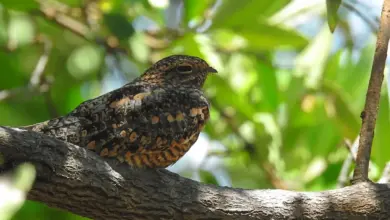The Red-necked Aracari (Pteroglossus bitorquatus) is a South American aracari that is native to Bolivia and Brazil, where it occurs south-east Amazon Basin and eastwards to the Atlantic coast on Marajó Island and the state of Maranhão, Brazil. Its range stretches only south of the Amazon River on the north, and southeastwards of the Madeira River in the west.
It inhabits subtropical or tropical moist lowland forests and heavily degraded former forest. Aracaris generally roost socially throughout the year. Up to five adults and their fledged offspring sleep in the same hole with their long tails folded over their backs.
Breeding
They nest in trees with appropriate hollows, most of which are previously made by woodpeckers. Other hollows are the result of a branch break and ensuing rotting of the heart wood from rain over a period of time.
Both the male and female share the incubation and chick rearing duties. The eggs are incubated for about 16 days.
The newly hatched chicks are blind and naked with short bills and thick pads on their heels to protect them from the rough floor of the nest. Both parents, as well as their previous offspring and/or possibly other adults, feed the chicks. The young fledge after about 6 weeks. The adults continue to feed them for several weeks after fledging.
Aviculture
Red-necked Aracaris are very energetic and need large, planted aviaries to thrive. As they are generally docile, it is possible to keep them with smaller birds. However, it is important not to place birds with them that are so small (such as finches) that they (or their offspring) could be considered as prey by these large birds. It is best to keep breeding pairs alone.
They may breed in nest boxes with a concave bottom. But, in general, they favor natural nests constructed from palm tree logs, which allows them to dig their nest chambers deeper.
Jerry Jennings, President / Director of Emerald Forest Bird Gardens provides the following input:
“Toucanets and Aracaris all require the same space. The smallest breeding flight I have used was 4′ x 10′ x 6 feet high and the flights I currently use are 8′ x 12′ x 8 feet high and the newest flights are 8′ x 16′ x 8 feet high.
They need the proper diet, a nest log and the pairs must be compatible.
I would start with the easiest, so when you have babies you will feel a sense of accomplishment and want to continue. If you start with a difficult species you will have much less luck and may become discouraged.” (Source: Jerry Jennings, President / Director of Emerald Forest Bird Gardens)




